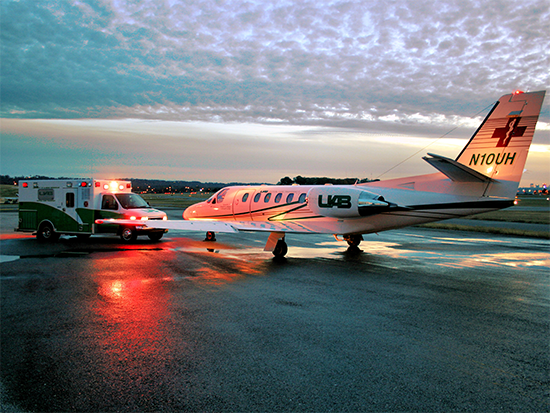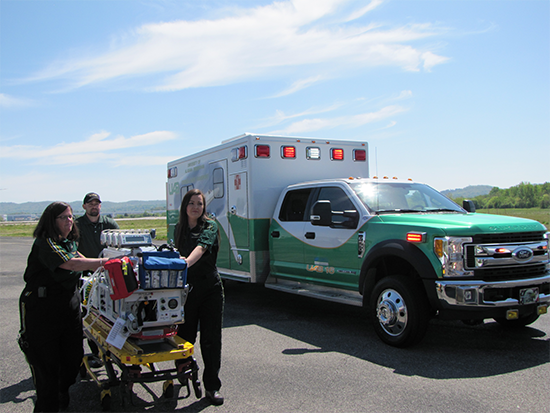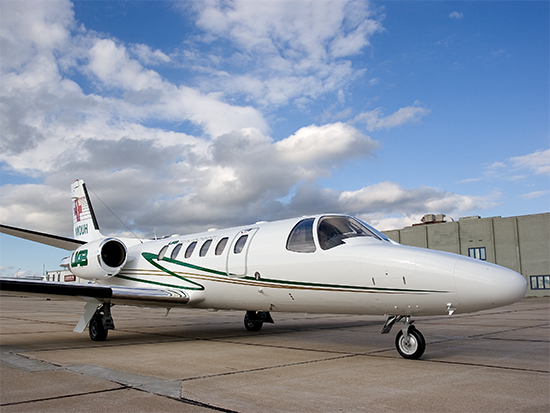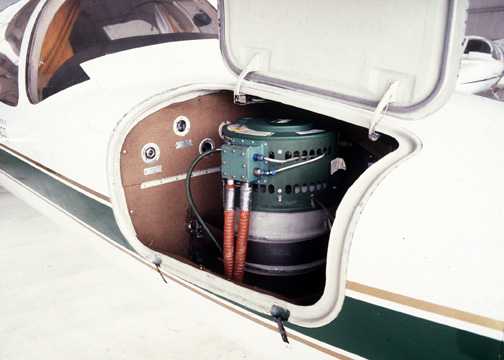 Critical Care Transport got its start in 1983, and has transported more than 60,000 patients by air and ground.The accomplishments are impressive: 21 patients evacuated by air from New Orleans following the double whammy of Hurricanes Katrina and Rita in 2005. Eight premature babies plucked from the path of Hurricane Gustave in 2008. The first United States civilian flight authorized in Cuban airspace since the revolution in 1959. The first civilian air ambulance equipped with a liquid oxygen system. The first patient placed on ECMO by the CCT team in an outside hospital prior to transport in 2020.
Critical Care Transport got its start in 1983, and has transported more than 60,000 patients by air and ground.The accomplishments are impressive: 21 patients evacuated by air from New Orleans following the double whammy of Hurricanes Katrina and Rita in 2005. Eight premature babies plucked from the path of Hurricane Gustave in 2008. The first United States civilian flight authorized in Cuban airspace since the revolution in 1959. The first civilian air ambulance equipped with a liquid oxygen system. The first patient placed on ECMO by the CCT team in an outside hospital prior to transport in 2020.
Even more impressive: 60,700 patients transported between hospitals since the Critical Care Transport Service was established at the University of Alabama at Birmingham in 1983. 2022 was another record-breaking year as CCT moved 2,570 patients.
In the early 1980s, UAB physicians realized that patients with significant medical issues requiring transfer to UAB for advanced care needed a better transport system than an ordinary ambulance. They needed vehicles with the same kind of equipment found in a hospital intensive care unit staffed by the same kind of medical professionals who work in those units.
 Critical Care Transport has three ambulances - rolling intensive care units - with a fourth on the way.That need led to the creation of the CCT, a UAB Medicine-based, inter-facility transport program for patients in the United States and worldwide who require transport from one medical facility to another. It is equipped with a jet aircraft — a flying ICU — and three ground ambulances — rolling ICUs — as well as the critical care nurses, respiratory therapists and physicians needed to make the transfers go smoothly and safely.
Critical Care Transport has three ambulances - rolling intensive care units - with a fourth on the way.That need led to the creation of the CCT, a UAB Medicine-based, inter-facility transport program for patients in the United States and worldwide who require transport from one medical facility to another. It is equipped with a jet aircraft — a flying ICU — and three ground ambulances — rolling ICUs — as well as the critical care nurses, respiratory therapists and physicians needed to make the transfers go smoothly and safely.
The first transport in 1983 was to take the first quad babies born in Alabama in which all four survived back to their home hospital after their birth at UAB. CCT has now transported patients from 38 countries and 48 states. Although a relatively small department, the clinical teams, transport coordinators and management team combine for an impressive 542 years of CCT experience.
“This level of experience is vital when operating away from the vast resources of UAB Hospital,” said CCT Medical Director Kevin S. Barlotta, M.D. “Our team serves to close the gap between patient need and resource availability, bringing the expertise and treatment modalities of UAB to the bedside of the outside hospital, where we can start delivering expert care and improve a patient’s condition before we hit the doors of UAB Hospital.”
“We have a lot of staff members who have long tenure with CCT, a number of whom have been with us for 20 years or more,” said CCT Director Laura Lee Demmons, who has been with the program for all of its 40 years. “We are a unique service as we can safely move the sickest patients over long distances to get them to the care they need to survive.”
 CCT has transported patients from 38 countries and 48 states.Originally conceived by William Goetter, M.D., a pulmonary critical care physician and then medical director of UAB’s Medical Intensive Care Unit, CCT has continued to innovate over the years. They were the first non-military aircraft/critical care transport program to add a liquid oxygen system, which allowed for cross-country transport of patients on ventilators.
CCT has transported patients from 38 countries and 48 states.Originally conceived by William Goetter, M.D., a pulmonary critical care physician and then medical director of UAB’s Medical Intensive Care Unit, CCT has continued to innovate over the years. They were the first non-military aircraft/critical care transport program to add a liquid oxygen system, which allowed for cross-country transport of patients on ventilators.
“It really resonated with us that we were the first to install liquid oxygen on our aircraft when we saw the serial numbers of our oxygen canisters,” Demmons said. “We had serial number one, and serial number two.”
They added cooling blankets in 2019 to be able to induce therapeutic hypothermia in newborns, a critical measure to preserve brain function in babies whose oxygen supply has been disrupted during the birth process. Hospital leadership recently approved $477,000 for new medical equipment, including $235,000 for a transport isolette for newborns that provides high-frequency ventilation and nitric oxide simultaneously, the first of its kind in Alabama. CCT’s neonatal team, made up of neonatal nurse practitioners and registered respiratory therapists, is now contracted to serve all neonatal ICU’s in the region.
“We have been continually cited for providing best practices in critical care transport by the Commission on Accreditation of Medical Transport Systems, as well as cited by their Board of Directors for being one of the few programs that has consistently achieved full accreditation with few contingencies,” Demmons said. “The Board also praised CCT’s excellent safety culture. This will be our ninth accreditation site survey.”
CCT was the first hospital-based transport program in Alabama and the surrounding five-state area to gain that accreditation, in 1999. The program has helped to advance the field of medical transport through participation in national/international professional associations, presentations at conferences, and multiple publications.
 CCT's jet was the first civilian air ambulance fitted with liquid oxygen, necessary for use of ventilators. The tanks were serial numbers one and two.There have been other high points. CCT was the first Western medical team to land in Petropavlovsk, Russia. The CCT team once used a gondola as ground transport in Italy. Their Hurricane Katrina experience involved multiple flights, bringing basic supplies in and flying sick patients out.
CCT's jet was the first civilian air ambulance fitted with liquid oxygen, necessary for use of ventilators. The tanks were serial numbers one and two.There have been other high points. CCT was the first Western medical team to land in Petropavlovsk, Russia. The CCT team once used a gondola as ground transport in Italy. Their Hurricane Katrina experience involved multiple flights, bringing basic supplies in and flying sick patients out.
The current aircraft is a twin engine Cessna Citation Bravo. It is one of the few medical jets that can carry two adult patients at one time, and the first Bravo in the world equipped with a clamshell door, which makes it easier to load stretchers. It was able to carry all eight of the premature babies airlifted from New Orleans after Hurricane Gustave, CCT’s personal record for most patients transported at one time.
A new ground unit is on order to keep up with the expanding volume. The ground units, weighing 18,000 pounds, are based on the Ford 550 chassis. They have enhanced safety features for the protection of crew and patients and redundancies in critical equipment, gases, suction and power.
“CCT has a remarkable track record over its 40-year history,” Barlotta said. “We’ve shown that we can answer the call to transport the sickest patients safely to or from anywhere in the world. Critical Care Transport is a valuable resource for the residents of Alabama, the United States and beyond.”
